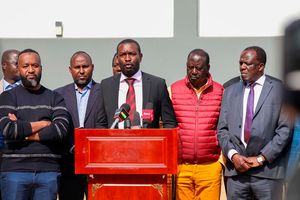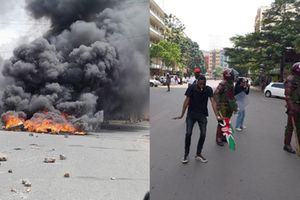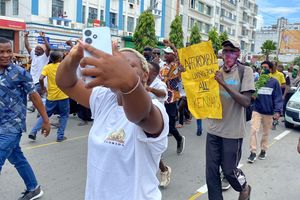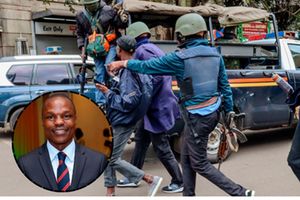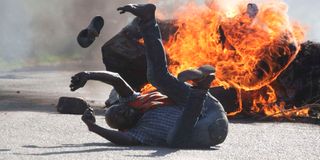
An anti-government protester demonstrates in Karatina town in Nyeri County on July 2, 2024.
Six politicians, a businessman and two NGOs are on the radar of State intelligence and security agencies following suspicion of their involvement in fueling ongoing anti-government protests.
Failure to obtain hard evidence of the suspects’ logistical and financial connection to the protesters has, however, intensified abductions as the State agencies seek grounds to arrest and prosecute them, interviews with multiple people familiar with the investigations have established.
The suspects are accused of mobilising youths from slum areas and giving them cash handouts with instructions to infiltrate and turn violent the protests by largely peaceful and unarmed demonstrators.
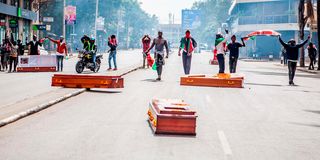
Anti-government protesters picket with coffins along Moi Avenue in Nairobi on July 2, 2024.
Three politicians from Nairobi, two from Central, one from Rift Valley, a businessman from Rift Valley and two Non-Governmental Organisations (one local and another international) are suspected to be financing the now three-week old anti-tax protests, according to a high-level intelligence brief seen by the Nation.
The hitherto peaceful protests turned violent on Tuesday last week culminating in the burning of a section of Parliament buildings, City Hall and many other public as well as private property across the country.
Tuesday’s protests were also characterised by closure of highways by stone-throwing goons, looting and damage of property.
The security dossier places blame on these individuals and entities whom it accuses of bankrolling some of the protesters.
The mass demonstrations have rocked Nairobi and at least 35 counties, forcing President William Ruto to announce the withdrawal of the Finance Bill, 2024 that contains a raft of widely unpopular tax increases.
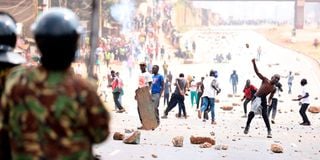
Protesters clash with police officers in during the anti-government protests in Kangemi, Nairobi on July 2, 2024.
National Assembly lawmakers on Tuesday last week passed the controversial Bill in defiance of raging nationwide anger against high cost of living, prompting angry protesters to storm the House.
At least 39 people have been killed and hundreds more injured in the anti-government demonstrations, according to the State human rights watchdog.
The government has sought to downplay the casualty figures, with the President even disputing the Kenya National Commission on Human Rights (KNCHR) tally.
The intelligence brief claims the individuals and entities were providing logistical support to the demonstrators, including transport to the epicentres of the protests, like the central business districts of major cities.
A Nairobi politician is accused of mobilising and hiring goons from Kibera, Mathare and babadogo areas.
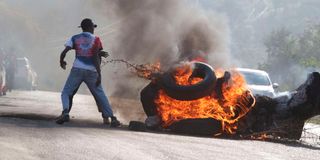
Anti-government protesters light a bonfire in Karatina town in Nyeri County on July 2, 2024.
Another politician from Nairobi is said to have held a series of night meetings to plan for the demonstrations, according to the intelligence brief that has been shared with top security chiefs in Nairobi.
Also under watch is a politician from the Rift Valley who is accused of holding a meeting of youths at his house in Nairobi to oil the anti-government protests.
The brief seen by Nation had names of the key suspects, which are, however, withheld for legal reasons.
Security agencies have been accused of going on an overdrive abducting political activists, online influencers and other individuals with huge following on social media in an attempt to infiltrate the planning and coordination of the protests.
The Generation Z age-group had taken pride in forming an online movement that has largely operated without a single leader, united by a quest to defeat the unpopular Finance Bill, 2024, as well as tackle the country’s corruption and governance shortcomings.
A special team of officers drawn from National Intelligence Service (NIS) and Directorate of Criminal Investigations (DCI) has been fingered for effecting the brazen abductions, of which the national human rights watchdog has recorded 32 cases, but intelligence sources say interrogations of the suspects have not yet yielded a smoking gun.
Former Nandi Hills MP Alfred Keter, the latest to be seized on Sunday before his wife and children, told journalists after his release that detectives questioned him about his relations with retired president Uhuru Kenyatta and deputy president Rigathi Gachagua.
Last week, Mr Gachagua publicly attacked NIS boss Noordin Haji, accusing him of failing to advise the President on the magnitude of the planned protests, and alleging a plot by NIS to link him and Mr Kenyatta to the mass demonstrations.
“Haji was peddling lies and propaganda trying to implicate former President Uhuru and me in the chaos,” Mr Gachagua told journalists in Mombasa as he demanded Mr Haji’s resignation.
A source familiar with the operations of the abduction squads told Nation that many of the kidnapped individuals did not yield information related to the demonstrations that the security agents have been looking for.
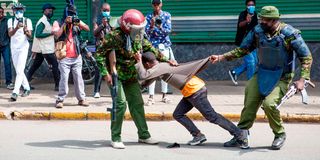
A protester is arrested by police officers along Moi Avenue in Nairobi during the anti-government protests on July 2, 2024.
The information being sought by the interrogators includes communication on the planning of the demonstrations, the leaders and financiers of the protests.
The source had also earlier blamed the frosty relationship between the police command and the intelligence leadership for the government’s inability to quell the unrest.
“You find that the National Police Service leadership and the NIS are not reading from the same script on how to go about some of these things. You will find that the IG may not even be aware of who is being held where,” said the source.
It emerged the government was at sea on how to handle the demonstrations as they seemed not to have a face or formal leadership.

